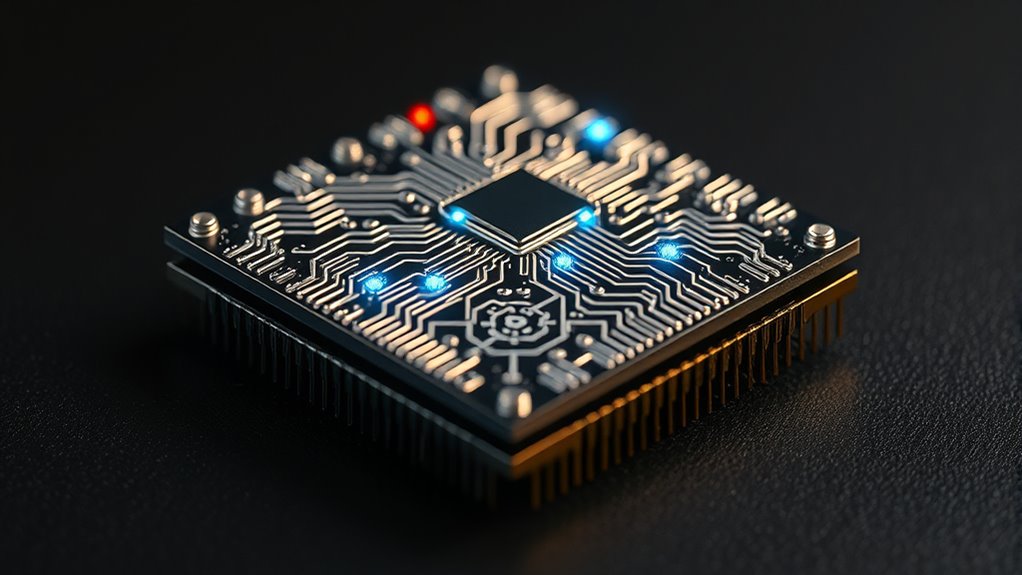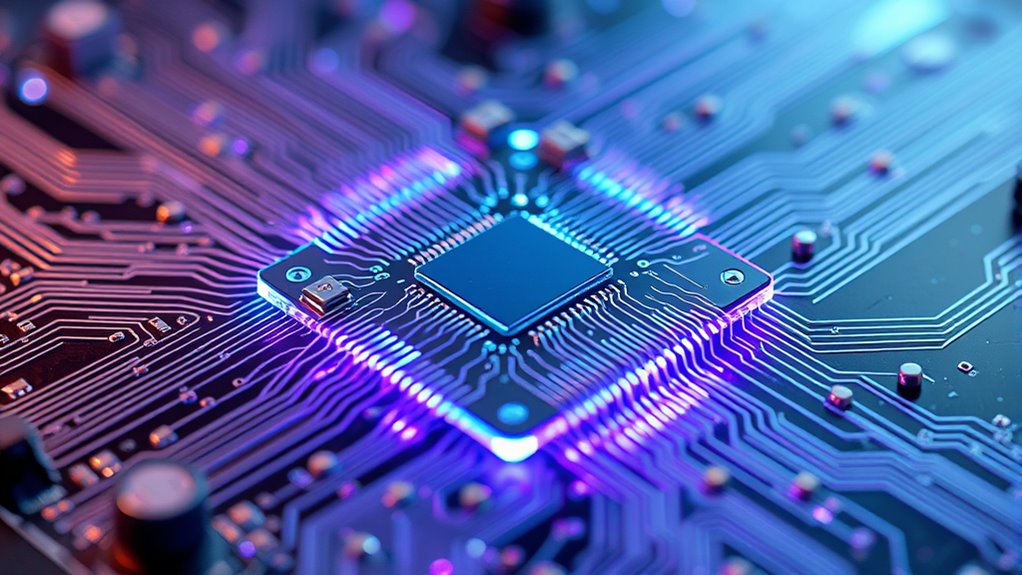Neuromorphic computing involves chips designed to think like brains by mimicking neural structures and functions. These chips use artificial neurons and synapses to process data in a parallel, event-driven way, making them more efficient and adaptable. They can learn, remember, and recognize patterns without relying on traditional algorithms. This enables smarter, low-power devices capable of handling complex real-world tasks. If you’re curious, exploring further reveals how these systems are revolutionizing technology and intelligence.
Key Takeaways
- Neuromorphic chips mimic brain structures using artificial neurons and synapses for processing information.
- They leverage parallel, event-driven architectures to enable real-time, low-latency computation similar to biological neural networks.
- These chips support hardware-based learning and adaptation, allowing them to improve performance without reprogramming.
- They significantly reduce power consumption and data transfer compared to traditional computing systems.
- Their design enables smarter, autonomous devices capable of handling complex tasks like perception and decision-making.

Have you ever wondered how computers could mimic the way our brains process information? Neuromorphic computing aims to do just that by designing chips that replicate neural structures and functions. Unlike traditional processors that rely on linear, clock-driven architecture, neuromorphic chips are built to emulate the brain’s parallel and event-driven processing. This approach offers remarkable improvements in hardware efficiency because these chips can perform complex tasks using markedly less power and fewer resources. By mimicking neural networks, they reduce the need for extensive data transfer and energy-consuming computations, making them ideal for applications where power consumption is critical. Essentially, you get faster, more efficient processing that aligns more closely with how biological brains operate.
At the heart of neuromorphic computing is cognitive modeling—an effort to simulate mental processes like learning, memory, and reasoning directly within hardware. Instead of programming explicit instructions for every task, you design chips that learn and adapt through interactions with their environment, much like human brains do. This shift means that neuromorphic systems don’t just follow pre-set algorithms; they develop their own solutions based on experience. For you, this translates into smarter, more flexible devices that can handle real-world complexity without constant human intervention. Whether it’s recognizing speech, interpreting images, or making decisions in unpredictable environments, these chips can dynamically adjust their behavior, thanks to their foundation in cognitive modeling.
The architecture of neuromorphic chips often involves artificial neurons and synapses, which work together to process information in a way that mirrors biological neural networks. This setup allows for highly efficient, low-latency communication between components, further enhancing hardware efficiency. Additionally, crochet techniques used in neural network design borrow concepts from biological structures to optimize information flow. Because of their design, these chips can process sensory data in real-time, making them suitable for robotics, autonomous vehicles, and IoT devices. As you use these systems, you notice how they learn over time, becoming more accurate and responsive without requiring extensive reprogramming. Their ability to adapt and learn directly within hardware reduces reliance on cloud-based processing, offering quicker responses and increased privacy.
Frequently Asked Questions
How Energy-Efficient Are Neuromorphic Chips Compared to Traditional Processors?
You might wonder how energy-efficient neuromorphic chips are compared to traditional processors. These chips excel in energy savings because they mimic how brains process information, leading to lower power consumption. Their architecture offers significant power efficiency, especially for tasks like pattern recognition and sensory processing. As a result, neuromorphic chips can reduce energy use while maintaining high performance, making them a promising technology for sustainable, low-power computing solutions.
What Are the Main Challenges in Developing Scalable Neuromorphic Systems?
You face scalability hurdles when developing neuromorphic systems because fabrication complexities increase as you try to expand chip size and functionality. Ensuring reliable, uniform components becomes tougher, and integrating diverse synaptic and neuronal structures adds layers of difficulty. Overcoming these challenges requires innovative manufacturing techniques and design strategies, so you can build larger, more capable neuromorphic systems that mimic brain functions effectively and efficiently.
Can Neuromorphic Computing Be Integrated With Existing AI Technologies?
You can integrate neuromorphic computing with existing AI technologies through hybrid computing, which combines brain-inspired architectures with traditional systems. This approach allows you to leverage neuromorphic chips’ efficiency and adaptability alongside conventional AI, enhancing performance and energy savings. By developing interfaces and compatible software, you make these technologies work together seamlessly, opening new possibilities for smarter, more efficient AI applications that mimic brain-like processing.
How Do Neuromorphic Chips Handle Learning and Adaptation Over Time?
You might think neuromorphic chips just mimic brain processes, but they actually excel at adaptive learning through synaptic plasticity. These chips dynamically adjust their connections based on activity, allowing them to learn over time like real neurons. This ongoing adaptation makes them capable of handling complex tasks without retraining from scratch, offering a flexible, efficient way to implement learning directly in hardware.
What Industries Will Benefit Most Immediately From Neuromorphic Advancements?
You’ll find robotics automation and sensory augmentation benefiting most immediately from neuromorphic advancements. These chips enable machines to process information more like the human brain, improving real-time decision-making and adaptability. Industries like manufacturing, healthcare, and security will see faster, smarter robots capable of complex tasks. By mimicking neural processes, neuromorphic tech enhances sensory devices and automation systems, making them more intuitive and efficient, and transforming how you experience and interact with technology.
Conclusion
Think of neuromorphic chips as the brain’s own echo, mirroring its incredible complexity. As you explore this innovative technology, realize it’s like planting seeds for a future where machines learn and adapt like you do. These chips aren’t just circuits; they’re the beginning of a new brain-inspired world. Embrace the journey, knowing that with each breakthrough, you’re helping build a smarter, more intuitive future—one neuron at a time.









